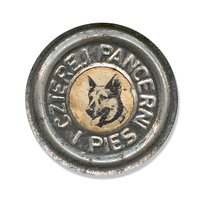Four Tank-Men and a Dog
This article includes a list of general references, but it lacks sufficient corresponding inline citations. (July 2020) |
| Four Tank-Men and a Dog | |
|---|---|
Poland | |
| Original languages | Polish German Russian |
| No. of episodes | 21 |
| Production | |
| Running time | 55 minutes |
| Original release | |
| Network | TVP |
| Release | 25 September 1966 – 1970 |

Four Tank-Men and a Dog (
The T-34-85 tank Rudy (
History
The first episode of the series was aired on TVP on 25 September 1966.[1] It was in TVP from 1966, 1969, and 1970, though it had multiple reruns on other channels.
The first series was based on Janusz Przymanowski's book Four Tank-Men and a Dog. After the first airing of the show, it rose in popularity quickly, leading to Przymanowski writing two other volumes of the book.
The next two volumes of the book were adapted into the second season (1969) and the third (1970).
Characters
The crew
- Olgierd Jarosz, "Olgierd", a tank commander, played by Roman Wilhelmi.
- Gustaw Jeleń, "Gustlik", a loader, played by Franciszek Pieczka.
- Jan Kos, "Janek", a gunner/radio operator, later the second commander, played by Janusz Gajos.
- Grigorij Saakaszwili, "Grześ", a driver. Native Georgian, played by Włodzimierz Press.
- Tomasz Czereśniak, "Tomuś" / Tomek", a second gunner, played by Wiesław Gołas.
- Szarik, "Kuleczka", the dog mentioned in the title of the series.
- Franek Wichura, a truck driver, played by Witold Pyrkosz. His surname means "gale", which is a relation to his energetic character.
Secondary characters
- Marusia "Ogoniok", a Russian nurse and Janek's love interest, played by Pola Raksa.
- Lidia Wiśniewska, "Lidka", a radio operator, played by Małgorzata Niemirska].
- Honorata, a former maid, played by Barbara Krafftówna.
- The colonel, Stary, played by Tadeusz Kalinowski.
- Corporal Daniel Łażewski, played by Tomasz Zaliwski.
- Obergefreiter Kugel, played by Stanisław Gronkowski.
At least two real tanks were used as "Rudy" in this series. One of them, used for tank interior scenes with cameras placed inside the hull, is now displayed in the
Although referred to as being armed with a 76 mm gun, the tanks seen in the show are the later model T-34/85.List of episodes
Season I, 1966
- Załoga (Crew)
- Radość i gorycz (Happiness and Bitterness)
- Gdzie my – tam granica (Where We Are, There's the Border)
- Psi pazur (Dog's claw)
- Rudy, miód i krzyże ("Ginger", Honey and Crosses)
- Most (Bridge)
- Rozstajne drogi (Crossroads [We Are Separating])
- Brzeg morza (Seashore)
Season II, 1969
- Zamiana (the Swap)
- Kwadrans po nieparzystej (A Quarter Past an Odd Hour)
- Wojenny siew (Wartime Sowing)
- Fort Olgierd (Fort Olgierd)
- Zakład o śmierć (Death Bet)
- Czerwona seria (Red Burst)
- Wysoka fala (High Wave)
- Daleki patrol (Long Patrol)
Season III, 1970
- Klin (Wedge)
- Pierścienie (Rings)
- Tiergarten (Tiergarten)
- Brama (Gate)
- Dom (Home)
Popularity


The popularity of the series came from it being one of the first postwar series to depict the era of World War II in a somewhat lighter vein. As the tragic events of the war receded, the Polish public became tired of the mandatory dark, tragic tone of previous television series and films dealing with wartime events. A similar change in attitudes occurred elsewhere in the world at the time. At the same time, the series was definitely not a comedy and contained many sad moments and intense battle scenes, while some of the main characters were wounded or killed. The series (especially in the first season) was very well prepared in terms of its technical side due to significant cooperation with the Polish People's Army and good military training of the actors (most of them being already trained as a two-year military duty was compulsory at the time).
All main heroes were in a way extraordinary. The youngest, Janek Kos, was a marksman, and owner of a well-trained and clever dog Szarik. The loader Gustlik, from Silesia, was very strong, while Grigorij (Russian name Grigoriy) was a skilled driver. Grigorij himself was a Georgian, representing numerous soldiers of the Soviet Red Army assigned to Polish tank units lacking specialists. The first commander Olgierd Jarosz was a meteorologist and could forecast the weather (in the book he was Russian Wasyl (Vasiliy) Semenov). Tomek, the last member of the crew (appearing later), was joyful and played the accordion.
The upbeat view of the war shown in the series was popular, but in many ways problematic. From the standpoint of military realism, the series is in fact almost grotesque, as its heroes have a very relaxed concept of military discipline, frequently fight their own "private" battles in defiance of orders, and effortlessly defeat German soldiers, who are depicted as faceless military incompetents. An emphasis is put on the friendship between front-line Polish and Soviet soldiers, but little or no mention of the problems in general
The series retained its huge popularity and was rerun yearly in Poland until 1989. After 1989 the series is still being sporadically shown in Poland. It was also shown in other countries of the
In 2006 the series was released on DVD as a boxed set by TVP.
In 2015, gaming company Wargaming introduced 4 premium vehicles to the game World of Tanks in an event marking VE day, one of the limited vehicles being Rudy, with a crew based on characters from the series including Szarik.
See also
- Captain Kloss
References
- ^ Knap, W. "PRL-owskie seriale i filmy historyczne bawią, lecz zakłamują historię". Dziennik Polski. Retrieved 7 July 2021.
- ^ [1] Archived 19 February 2005 at the Wayback Machine
External links
- Czterej pancerni i pies at IMDb
